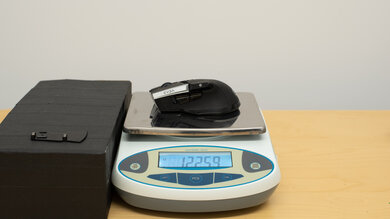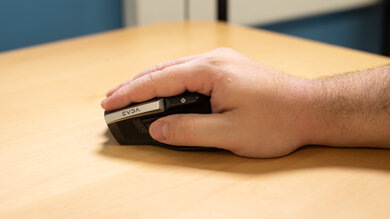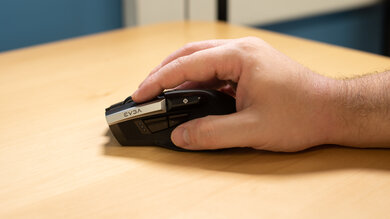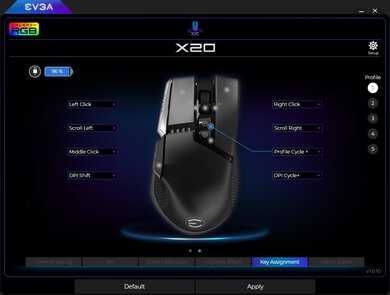The EVGA X20 is a wireless gaming mouse with an angular gamer aesthetic and a solid plastic body with a thumb rest. It has three side buttons, including a sniper button and a scroll wheel with L/R tilt inputs. Also, it has two buttons behind the scroll wheel, which cycle through custom profiles and CPI settings by default. Its right-handed shape is comfortable and well suited for all grip types and most hand sizes, and there are textured grips on either side. Performance-wise, it has good click latency, and you can precisely adjust the CPI by increments of 50 within a broad range. This mouse has two additional lift-off distance sensors that EVGA claims provide lower and more precise lift-off distances; however, this feature doesn't work as advertised on the model we tested, and the minimum lift-off distance is higher than on many other comparable gaming mice.
Our Verdict
The EVGA X20 mouse is great for office and multimedia work. It feels well-built and has a comfortable, right-handed shape suitable for most hand sizes using any grip type. You can connect it using its USB receiver or via Bluetooth, and you can also reprogram all of the buttons on the top of the mouse using the customization software. Unfortunately, while the mouse wheel has L/R tilt inputs, it lacks a free-scrolling mode.
-
Feels well-built.
-
Comfortable right-handed shape with a thumb rest.
-
All buttons on the top of the mouse are programmable.
-
Connects wirelessly with a USB receiver or via Bluetooth.
-
Scroll wheel lacks a free-scrolling mode.
The EVGA X20 is a decent FPS gaming mouse, but it's very heavy, and while its click latency is good, some gamers may prefer a more responsive-feeling option. That said, it feels well-built and has a comfortable, right-handed shape suitable for most hand sizes and all grip types. You can precisely adjust the CPI by increments of 50 within a broad range, and it has a fairly low minimum lift-off distance. However, you can't adjust it as low as EVGA advertises, and it's higher than many other mid-range FPS gaming mice.
-
Feels well-built.
-
Good click latency.
-
Very heavy.
-
Mouse feet have some sharp edges and don't glide as smoothly as those on many other gaming mice.
The EVGA X20 mouse is great for MMO gaming, but it doesn't have as many buttons as a dedicated MMO gaming mouse. That said, you can reprogram all of the buttons on top of the mouse using the customization software. Performance-wise, it has low click latency, and you can adjust the CPI precisely by increments of 50 within a wide range. It also has a low minimum lift-off distance, but it's higher than on many similar gaming mice, and you can't adjust it as low as EVGA advertises on the unit we tested.
-
Feels well-built.
-
Comfortable right-handed shape with a thumb rest.
-
All buttons on the top of the mouse are programmable.
-
Mouse feet have some sharp edges and don't glide as smoothly as those on many other gaming mice.
The EVGA X20 mouse is sub-par for ultra-lightweight gaming as it's significantly heavier than dedicated lightweight gaming mice. While it has good click latency, gamers who play competitive or reaction-based games may prefer a more responsive-feeling option. That said, it feels well-built and has a right-handed shape suitable for all grip types and most hand sizes.
-
Good click latency.
-
Very heavy.
-
Mouse feet have some sharp edges and don't glide as smoothly as those on many other gaming mice.
-
Braided charging cable retains kinks and is fairly rigid.
The EVGA X20 is an impressive travel mouse, but it's bulky and likely won't fit in most laptop cases. Despite this, you can connect it wirelessly with its USB receiver or via Bluetooth. It has onboard memory for carrying over custom settings on systems without the software installed and a comfortable right-handed shape suitable for all grip types and most hand sizes.
-
Feels well-built.
-
Comfortable right-handed shape with a thumb rest.
-
Connects wirelessly with a USB receiver or via Bluetooth.
-
Has a storage compartment for its USB receiver.
-
Bulky; likely won't fit in most laptop cases.
- 8.1 Office/Multimedia
- 7.4 Video Games (FPS)
- 8.1 Video Games (MMO)
- 6.6 Ultra-Light Gaming
- 8.2 Travel
Changelog
- Updated Sep 28, 2022: We've converted this review to Test Bench 1.2. This update simplifies our Weight test and expands on our CPI test from Test Bench 1.1, resulting in changes to test results in both sections. For more details, you can see our complete changelog here.
- Updated Sep 21, 2022: We've converted this review to Test Bench 1.1. This update revamps our Click Latency test and results in changes to test results. For more details, you can see our full changelog here.
- Updated Nov 05, 2021: Review published.
- Updated Nov 02, 2021: Early access published.
- Updated Sep 20, 2021: Our testers have started testing this product.
Check Price
Differences Between Sizes And Variants
The EVGA X20 gaming mouse we tested is black, but there's also a gray colorway available. You can see the label for our unit here.
Compared To Other Mice
The EVGA X20 is a good mid-range wireless gaming mouse. It belongs to a lineup of three mice from EVGA that includes the EVGA X15 and the EVGA X17. The X17 is very similar to the X20, but it's a wired-only model with a different primary sensor, a set of extra weights, and a higher maximum polling rate. On the other hand, the X15 is a wired model designed for MMO gaming with plenty of additional buttons. Both the X17 and X20 also feature a pair of additional LOD sensors, which EVGA claims can achieve much lower lift-off distances than competing gaming mice. However, while we had no issues with this feature on the X17 we tested, the feature doesn't work as advertised on the X20 unit we tested.
For more recommendations, see our picks for the best mouse, the best gaming mouse, and the best wireless mouse.
The EVGA X17 and the EVGA X20 are similar FPS gaming mice belonging to the same lineup. The X17 is a wired-only model that's lighter but also includes a set of additional weights for adjusting the weight distribution. It also has a higher maximum polling rate of 8000Hz. On the other hand, the EVGA X20 connects wirelessly with its USB receiver or Bluetooth, or you can connect it with its charging cable. It also has a more consistent sensor. Both mice have a pair of extra lift-off distance sensors EVGA claims can provide much lower lift-off distances than other gaming mice. However, this feature doesn't work as intended on the X20 we tested, and the X17 has a lower lift-off distance despite using the same technology.
The Gamesense Meta is overall better for gaming than the EVGA X20. The Gamesense is much lighter, and it has a better quality and more flexible cable. Its mouse feet are also better quality and glide much smoother. It has a lower lift-off distance and lower click latency. That said, the EVGA has a wider CPI range with a more precisely adjustable CPI. Also, it has more programmable buttons, and you can use it wirelessly via its USB receiver or Bluetooth.
The ASUS ROG Gladius III Wireless is a better wireless gaming mouse than the EVGA X20. The ASUS is significantly lighter and feels sturdier. It also has a more flexible charging cable and slightly better-quality mouse feet, though they don't provide as smooth of a gliding experience. The ASUS also has a higher maximum CPI, a lower minimum lift-off distance, lower click latency, and hot-swappable L/R click-button switches. On the other hand, the EVGA X20 has a thumb rest, two additional buttons, and its scroll wheel has L/R tilt inputs.
The GLORIOUS Model O is an excellent, ultra-lightweight gaming mouse, while the EVGA X20 is a decent FPS gaming mouse. The GLORIOUS is a wired-only model and has a honeycomb shell. It's significantly lighter and has mouse feet that glide more smoothly. It also has a more consistent sensor, a lower lift-off distance, and slightly lower click latency. On the other hand, the EVGA connects either wirelessly with its USB receiver or Bluetooth or with its charging cable. It has a thumb rest, four additional buttons, a wider CPI range, a more precisely adjustable CPI, and a scroll wheel with L/R tilt inputs.
The Logitech G PRO X SUPERLIGHT is an outstanding ultra-lightweight wireless gaming mouse, while the EVGA X20 is a decent full-featured wireless gaming mouse. The Logitech is significantly lighter and feels sturdier. It also has mouse feet that glide more smoothly, a much higher maximum CPI range, a more consistent sensor, a lower lift-off distance, and significantly lower click latency. The software is compatible with Windows and macOS, while the EVGA software is only compatible with Windows. On the other hand, the EVGA has five additional buttons, including an extra side button. It also has a thumb rest, a mouse wheel with L/R tilt buttons, and Bluetooth support.
The Logitech G Pro Wireless is a gaming mouse with better overall performance than the EVGA X20. The Logitech is significantly lighter and feels sturdier. It also has mouse feet that glide more smoothly and a pair of buttons on both sides. Performance-wise, it has a much higher maximum CPI, a more consistent sensor, a lower lift-off distance, and a significantly lower click latency. Its software is compatible with Windows and macOS, while the EVGA software is only compatible with Windows. On the other hand, the EVGA has two additional buttons and a thumb rest. It also has a scroll wheel with L/R tilt buttons and Bluetooth support.
The EVGA X15 is an excellent wired MMO gaming mouse in the same lineup as the EVGA X20, which is a decent, wireless FPS gaming mouse. The X15 is somewhat lighter, it has ten additional buttons, and it has a higher maximum polling rate of 8000Hz. You can also set an E-Shift button using the software to enable a second layer of commands. On the other hand, the X20 has a thumb rest and feels sturdier. It connects wired with its charging cable or wirelessly with its USB receiver or Bluetooth.
The EVGA X12 and EVGA X20 are fairly different gaming mice within the same product lineup. The X12 is a wired-only, true ambidextrous mouse that's significantly lighter. It also has a lower minimum lift-off distance, better click latency, and a higher maximum polling rate. On the other hand, the X20 has a right-handed shape with a thumb rest and connects wirelessly with a USB receiver or Bluetooth.
Test Results
The EVGA X20 gaming mouse feels solidly built overall. The plastic feels high quality, and there's no flex or creaking in any of the panels. Unfortunately, if you squeeze into the left side of the mouse with a little force, you can activate the side buttons. However, this won't present problems during regular use.
EVGA claims this mouse has up to 60 hours of battery life without RGB lighting and 24 hours of battery life with RGB lighting on. You can check the battery level using the software, but there's no indicator on the mouse.
You can reprogram all of the buttons on the top of the EVGA X20, but you can't reprogram the up/down scroll inputs, and the software forces you to have a button assigned to the left-click functionality at all times. You can set custom profiles and five CPI settings per profile. The button that's marked with a "P" behind the scroll wheel cycles between profiles by default, while the button marked with a "D" cycles between CPI settings for the profile you're using. There's also a cluster of LED lights on the left side that indicate what CPI setting you're using.
The polling rate options on the EVGA X20 are 125Hz, 250Hz, 500Hz, and 1000Hz. While the sensor on our unit is fairly consistent, it's also fairly inaccurate and undershoots the set CPI by 7.36% during slow cursor movements and 15.21% during faster movements.
Note: In addition to its primary sensor, this mouse has two dedicated lift-off sensors. EVGA claims this can produce a lift-off distance as low as 0.4mm, but despite multiple retests using the "extreme low" setting, we couldn't achieve a minimum lift-off distance lower than 2.4mm during our tests. If you have this mouse and have experienced issues with the LOD or any other aspect of this mouse, we'd love to hear from you in the discussions.
This mouse lacks customization software for macOS, so you can't create custom profiles, and the profile switching button is unfortunately useless for Mac users. However, the default functionality of all other buttons works fine.
Comments
EVGA X20: Main Discussion
Let us know why you want us to review the product here, or encourage others to vote for this product.

































